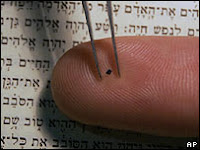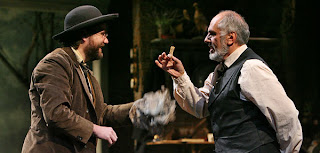Hello from Long Lane Honey Bee Farms, and greetings from David & Sheri! This is the time of the year when our family celebrates the birth of Jesus, and enjoys time with relatives. Not to mention it's also the time of the year I eat too much homemade yummies! So Merry Christmas from our family to you.
Today, I thought I was going to talk about requeening a hive, but I want to answer some common questions surrounding the matter of how many hives to start with when keeping bees. I'll try and get to requeening next time. Before I share today's lesson, let me tell you a few other things. The kind of things friends chit-chat about when they first get together...
I haven't heard a peep out of my bees. In fact, their hives are all covered with snow. Take a look at the picture below of some of my hives. I took this picture Saturday. You can click on the picture to see a larger version. Isn't that pretty? I think you can right click on the picture and save it to your computer and make it your desktop background image!

You might be wondering about my entrances being glogged with snow. Normally, I would clear them after each snow. However, since I use screen bottom boards, I don't worry about ventilation through the entrance. But, I will need to clear it out before the next warm day when the bees will want to take a potty break.
I like it when it get's cold like this because it keeps my bees in a warm tight cluster, not eating much. If we have warm winters, they can get more active and eat more. I'm often guilty of taking off more honey than I should have, cutting the bees pretty close on winter reserves.
Now for today's lesson! How many hives should you start with?When getting started in beekeeping, a common question is, "How many hives should I start with?"
Many people who are first starting out wonder if they can handle more than one hive. They rationalize that if beekeeping doesn't work out, then it is easier to get out of it with only one hive. Let me tell you what my opinion is on how many hives to begin beekeeping.
Keep in mind that colonies of honeybees can and do sometimes die out even after we do everything right. I call it a natural death. If you have only one hive, and it goes wrong, then you don't have any hives left! With a few hives, two or more, you're always able to compare hives and keep going even though you might lose one along the way.
Click here to see our two hive discount. I'm not ashamed to admit it that I've lost a few hives due to my own neglect or mismanagement. I'm just thankful I had a bunch of other hives to do it right with after I learned from my mistakes. This is why it is better to start with multiple hives than just one.
When people ask me how many should they start with, I usually tell them, "As many as you can afford". Many people who start with one or two usually call back and order more the next year. For those who truly enjoy beekeeping, they are always seeking ways to add more hives to their apiary. I realize that available space and time has to be considered. However, there is always a way to gain more places to place bees without having to buy land. Many farmers and land owners will gladly let you place your bees on their property for nothing more than a few jars of honey in return.
The average backyard hobbyist should always start with 2 or more. Why? With two hives, you can compare the hives to each other. Usually if both hives are acting the same way, it is a normal bee "thing". If one colony loses its queen, then you can place a frame of brood with 1-3 day old eggs from the other hive into your queenless hive and they will raise their own. And if one colony becomes weak, you can equalize the two hives by adding more bees to the weaker hive. With one hive these management practices are not possible.
Let me answer several questions that I am asked regarding the number of hives to begin with:
If I get more than one hive, will it require a lot of time?How much time you dedicate to beekeeping is entirely up to you. The extemes are, you can do nothing more than install your package in the Spring and do nothing at all, to the other extreme of inspecting your hives every two weeks. A good management practice is to inspect you hives every two weeks. This should only take about 15 minutes per hive. So for two hives, that's only a hour a month. But, here's how it really works for a lot of folks just getting started in beekeeping. They love it so much, they are always in the hive, looking at it, pulling frames out and showing friends and realtives. I opened one hive 5 times in one day show interested people the inside of a hive. It does disrupt their activities, so it is best to limit your inspections to twice a month, but some new beekeepers can't stay out of the hive, because it is so much fun. And the distruption is worth the experience you get by opening up the hive. With the more hives you have, the more you can inspect different hives and enjoy your hobby more.
I once had a real nice motorcycle the kind you have to polished after every ride. I spent less time keeping 100 hives than keeping that motorcycle waxed! It really is manageable.
With several hives, will the bees from one hive be confused and not know which is their hive?Will the hives fight each other?Bees keep to themselves pretty well. Each hive has a unique smell, to the bees, not to us. They will not bother other hives. As you can see by the snow picture above, I try to keep about 6-8 inches between my hives so that on windy days, they don't drift into the wrong box. Even if a few do, it is not a big deal.
Will they fight each other? No. They keep to their own business. In the fall, during a dearth of nectar, a very strong hive might try to rob a very weak hive. But through proper management this will not be an issue. Proper management means keeping hives equal and avoiding attracting bees to another hive by mishandling honey or honey supers in the weak hive. Don't work a weak hive for very long in late summer or early fall.
How close together can I place multiple hives? I've had hives on pollination pallets which were only 3/4" a part from each other, 4 hives on a pallet. But I think 6 - 8 inches is a minimal. And if you have a bit more space, give them a foot or two. Don't place them too far a part or else you'll be walking too much to work them. I keep them close so I can go right down the line when I am working my hives. If you have more 4 or more, try to make a "U" shape bee yard, like a horseshoe shape apiary yard. This helps the bees identify their hive quickly and it provides a little wind break for landings and takeoffs.
Can too many hives in one area deplete the available nectar source?I've heard people argue that too many hives in one area can cause a depletion in nectar in that area so that only the strong hives do well. That might be possible if you live in the middle of a desert with only a hand full of flowers within 12 miles.
Most of us live in areas where there is plenty of nectar sources. Bees are sharp when it comes to finding nectar. Just like we are sharp in finding food when we are hungry. You know where some good restraunts are and if you don't you know how to go out looking for that perfect steak house. Bees are even better than we are at finding food.
It is extremely important to remember that bees fly 2-3 miles out to gather nectar. I think some people think of bees as dogs, meaning that they think the bees will stay in their yard. Unless you have a huge yard, it aint' going to happen.
Now, let's say you live in town and you own a regular lot where beekeeping is permissible. Your bees will fly 2 to 3 miles around searching for nectar. One of my bee yards is located just on the edge of a city of 10,000 people. The bees fly straight up and out and late this summer they brought in a lot of alfalfa honey. They weren't getting this in town!
Within a 2 mile radious there are over 8,000 acres. A 3 mile radius includes over 12,000 acres of nectar to choose from! Wow!
Now, to better illustrate how much nectar is within a 3 mile radius, I've taken a satelite image of my home where I have about 30 hives. I have superimposed a circle that represents a 3 mile radius. Look at how much land that emcompasses.

Even though I'm about 4-5 miles away from some towns near me, it's only about 3 miles the way the bee flies. And if you notice near the top of the picture, there is a large river that runs through the 3 mile radius which means lots of river bottom flowers even in dry weather.
It just makes better practice to start with two or more hives. I started with one hive and through neglect it died off and since I had only one hive, I was out of beekeeping for several years.
Now don't let me discourage you if you can only start with one hive. You can start with one and do great! You can add more and more hives as the years go by. And, your one hive may never die. Instead, you might get many splits from your first hive. You just never know. But, your chances of success are increased by the more hives you have.
Thanks for dropping by and spending some time with me today, talking about beekeeping. It's lots of fun, isn't it! Feel free to email me some questions and I'll be happy to consider turning them into some future lessons! Together we're all learning so much!
You can order directly from us, at 217-427-2678!
See ya next time and remember to BEE-Have yourself!
David & Sheri
 Happy New Year!
Happy New Year!





















.jpg)





0 comments:
welcome to my blog. please write some comment about this article ^_^